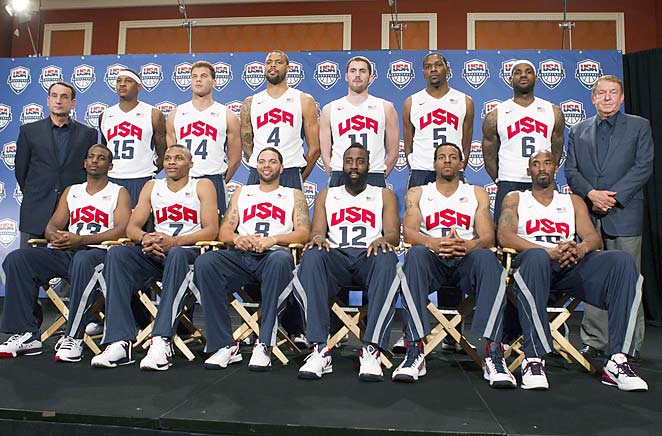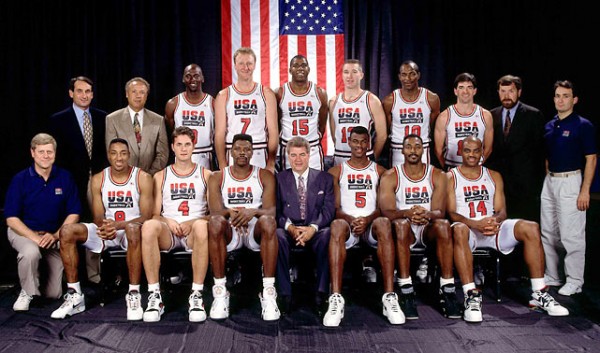News You Can Use- Team USA Announces the 2012 Olympic Basketball Roster
Team USA recently announced their basketball roster for the 2012 Olympics in London and all the experts are already dissecting the choices. Certainly Coach Mike Krzyzewski can teach us a lot about how to coach basketball. The job he and Team USA led by Managing Director Jerry Colangelo did in picking the 2012 team is entirely different animal than picking a basketball team in high school or recruiting a basketball team at the college level, but we can all learn from their philosophies.
Most high school basketball coaches and middle school basketball coaches have a very limited number of players to choose from. Many college basketball coaches recruit very large areas, some nation or worldwide, trying to find players that are 1. talented enough, 2. high enough in character (well, some schools look at this), 3. able to get into and succeed academically at their school (ahem), 4. will fit into their system or style of play., & 5. that they can get! If a college basketball coach doesn’t have a realistic shot to get a recruit to come to their school then the coach doesn’t need to waste their time on them.
(If you’re interested, I discussed four different strategies for picking your basketball team at tryouts, mainly aimed at high school basketball coaches and middle school basketball coaches in a blog post from Oct. 2011. You can read that post by clicking here http://www.coachingbasketballwisely.com/tryouts/ )
So what about picking a basketball team at the National Team level? Is it really that different?
Granted the team will be together a very short period of time and there were several significant injuries to players expected to contribute, but I think we can learn a lot from the philosophy of Team USA. The rest of the world has gotten so good at basketball that picking this team is not like the 1992 Dream Team where Team USA was expected to win, and win big, every game.
Rick Bonnell wrote an excellent article in The Charlotte Observer (read the full article here) and provides these tips for coaches…
“Krzyzewski injects the word “versatility” into every description of this team. That’s not wishful thinking, and it’s not exclusive to James, the NBA’s regular-season and Finals MVP. With New York’s Carmelo Anthony and Oklahoma City’s Kevin Durant and Russell Westbrook, he has players whose skill sets are as wide as the Grand Canyon.
That would be an advantage in any situation, but it particularly fits Krzyzewski’s approach. From his first seasons at Duke, Krzyzewski cast aside labels. Other than point guard, he never believed in calling a player a “small forward” or a “shooting guard.” And he never bought into the numbers system where a center is a “5,” a power forward a “4,” etc.
He once explained that when you lean on labels, you feel obliged to replace your starting “4” with the next best “4.” When, in fact, the next best “4” might be the fourth-best player on your bench.”
Krzyzewski would rather put his best five options on the court and make the other team adapt to him. This squad certainly provides that opportunity.”
In my experience I always tried to avoid labeling players for several reasons. If you use numbers to label your players (1, 2, 3, 4, 5) then most kids don’t want to be a 5- they want to be a 2 or 3. If you use titles (point guard, shooting guard, small forward, power forward, center) then no one wants to be a center. I even tried using “point guard,” “wings,” and “forwards” but this made it hard to diagram plays because of the 2 “W’s” and “F’s” on your dry erase board! If I am drawing a play up in a timeout then I simply use player initials. I like this because it also eliminates the “I thought I was the 3” excuse when someone goes to the wrong spot- just watch out if your players have the same initials!
I also always tried to sell to my players that I wanted five players on the court who could dribble, pass, and shoot versus pressure- not versus Grandma in the driveway or spot up jumpers versus air. Versatility is a huge positive for any player. Right now, college coaches in America have just hit the road again this July looking for that next recruit and most would rather have a player who is versatile- meaning that can play multiple positions on offense and guard multiple positions on defense. Sometimes a player can do this on offense, but not on defense- or vice versa. Most coaches would prefer a versatile player in college basketball recruiting.
They used to say you could not win championships without a dominate big man (center or 5!), but Team USA will once again put that theory to the test. Bonnell continued in his article with these insights,
“The last roster spots on this 12-man squad went to two power forwards – Kevin Love and Blake Griffin – and shooting guard James Harden. Asked why Team USA wasn’t more intent on finding another center to complement former Charlotte Bobcat Tyson Chandler, Colangelo was blunt:
“There are a lot of 7-footers who can’t play. There are a lot of 6-9, 6-10 guys better than those 7-footers. We’ve seen Griffin go up against (Spain’s Marc) Gasol. Matchups go two ways – they have guard our quickness, our speed.”
That’s where Krzyzewski comes in. He envisions an offense that is hard to scout because it lacks tendencies. It lacks tendencies because James, Anthony and Durant won’t be pigeon-holed into just doing certain things.
“The way we’re going to run offense is not 1-2-3-4-5,” Krzyzewski said.
“The offense that we’re trying to run gives them actions they can improvise. No one is married to a certain spot on the floor. You don’t want to do that to these guys. (The) main thing for us is spacing and versatility in what we can do.”
Coach K’s mentor, Coach Bobby Knight says that “offense is spacing and spacing is offense.” When you have players as talented as Team USA you definitely want to give them a framework that gives them the spacing and the opportunities to use their abilities. It will be interesting to see how this all plays out at the 2012 Olympics in London, but to answer my own original question- Yes; I do think Coach K knows what he is doing!
I’d love to hear any of your tips or stories on picking your teams- no matter where or what level you coach at! Please leave a comment or email me and let’s all share our knowledge and experience with each other.
Until next time, Coach ’em up!
Hal Wilson
After coaching and working with basketball teams at the college and high school level in a variety of roles for 18 years, I have returned to graduate school to finish my Ph.D. in Kinesiology. This www.CoachingBasketballWisely.com website is a way to share the coaching tips, strategies, and techniques gathered in a career in coaching. See more on my background info on me here. Please sign up for our free newsletter at the top right of the page and l would really appreciate it if you would leave our podcast a rating on iTunes here.
If you like what we do PLEASE leave us a rating on iTunes & sign up for our free newsletter at the top right.
-
For the best Basketball Coaching Videos & DVD’s from Coach K please click my affiliate link below:
Mike Krzyzewski DVD & Videos
-
For the best Basketball Coaching Books from Coach K please click my affiliate links below:





Comments on this entry are closed.
In college we would play small sometimes and I would be bumped from the 2/3 to a 4 man to me it didn’t make a difference where I played because I knew that I was just going to go out there and play. Too many young players fall into the idea that if they are setting screens then they are not going to get enough shots or touches. This is just the opposite though because a lot of the time the man who sets a good screen will get the ball because his man is conditioned to help on the screen. I found your article very helpful. Keep up the good work.